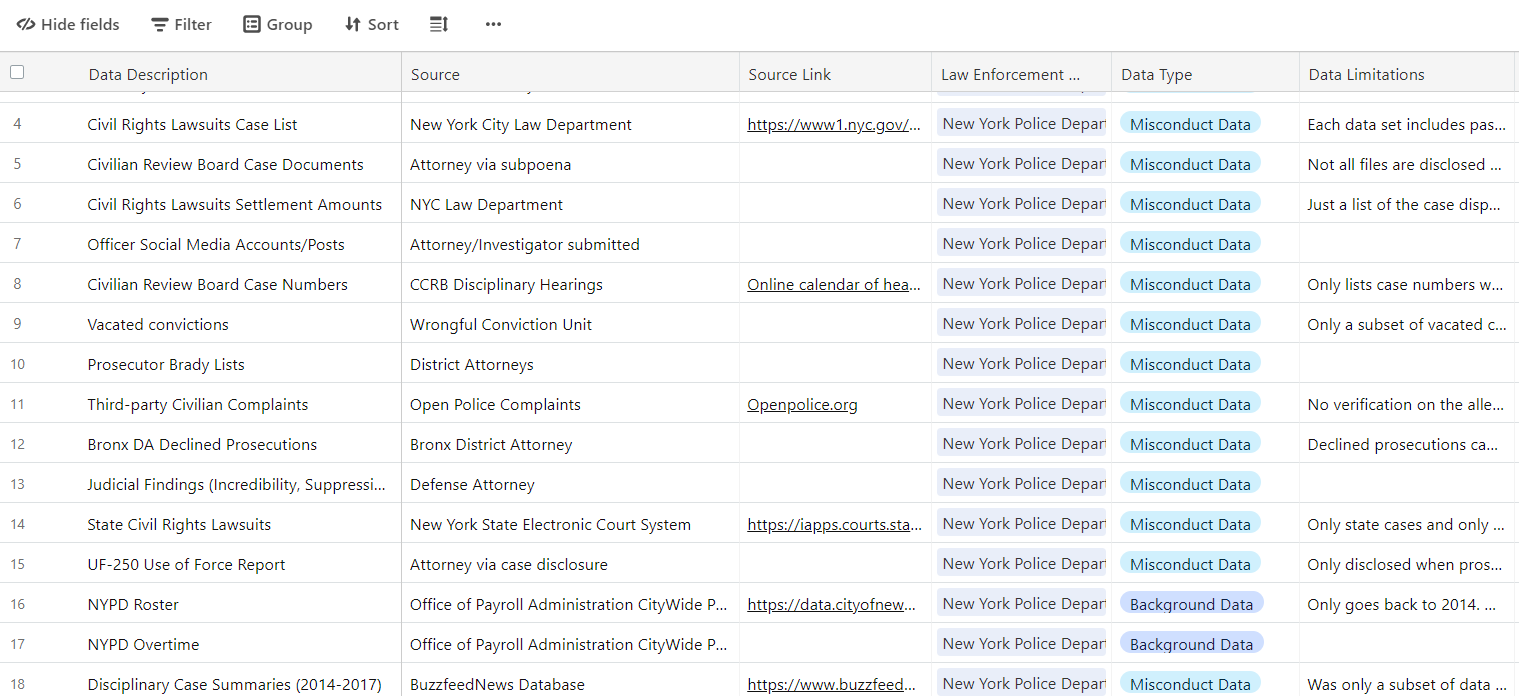Example Data Collection Plan
Here is an example data collection plan.
Templates:
- Airtable template – make a free Airtable account then click "copy base" in the upper left.
- Excel template – use the template attached at the bottom of this page
1. Law Enforcement Agencies
First, list which law enforcement agencies you want to track. If there is more than one, rank-order them by priority.
2. Data Sources
List all sources of data that exist to your knowledge for those agencies - regardless of whether you can access them. Look through our list of potential data sources. The goal is to list all data that you know exists, you will decide later whether it's worth the time and resources to collect it.
For each data source, in your data collection plan:
-
“Data Description” – list out all the possible types of data. Do this for both the misconduct data that you plan to track – federal civil rights lawsuits, internal affairs investigations, etc. - and any background data you might need – officer rosters, department command lists, etc. Include all data sources, even if you don’t have the rights to access them.
-
“Data Type” – list whether this is background or misconduct data
-
“Source” – for each type of data, list your source. Be specific. If you obtain a type of data data from multiple sources, then make a row for each unique source. For example, for “civil rights lawsuits”, you may have multiple sources, like PACER, RECAP, Westlaw.
-
“How to Obtain” – describe how you would get the information for that source, if applicable. Ex: submit a Freedom of Information Act Request, do you need a subpoena, or Is it available online?
-
“Law Enforcement Agencies” – list the law enforcement agencies that data is about. If there are different sources for each agency, separate them into different rows
-
“Data Limitations” - write down any inherent biases or issues with the source of the data. What are the limitations of this data? What biases might exist in the data? Are records getting expunged? Does the data only go back so far? Do the records only include substantiated findings? etc...
-
“Confidentiality” - list the confidentiality level of the information. Is this data public information? Protected under attorney-client privilege? Protected under a court order? Statutorily confidential?
-
“Sharing Limitations” - record any limits there could be on sharing this information if you were able to obtain it. Does it depend on the purpose and with whom?
3. Partners and Collaborators
Next, decide if you will embark on this project alone or with partners/collaborators. Look at your data collection plan and ask yourself, are there any other groups who might have or be interested in the same data? Consider journalists, community groups, universities, innocence projects, and/or civil rights attorneys.
- “Collector” - if multiple people or organizations will be collecting data, list who will collect each type of data.
4. Triage/Prioritize
Now prioritize what you have capacity to collect. You might only be able to collect data passively as you learn about it through articles, court disclosures, or reports rather than proactively searching for it.
-
"Improve Access” - write down any laws, consent decrees, or procedures that you believe could be changed to increase access to information. Are records being expunged because of a police union contract? Are prosecutors or police departments seeking protective orders? Are there associated costs? This may not make sense for all your data sources.
-
“Collection Rate” - Decide how frequently you would like to check those sources. For public sources, this will ideally be as frequently as you have capacity. For information obtained through cases, this will likely be “As Submitted” by attorneys to the database.
Save your data collection plan. Use it to coordinate data collection in your organization or group and update it as your time, staffing, and resources change.
5. Next, choose a system for organizing your law enforcement misconduct data.
◄ How to Track Police Misconduct













